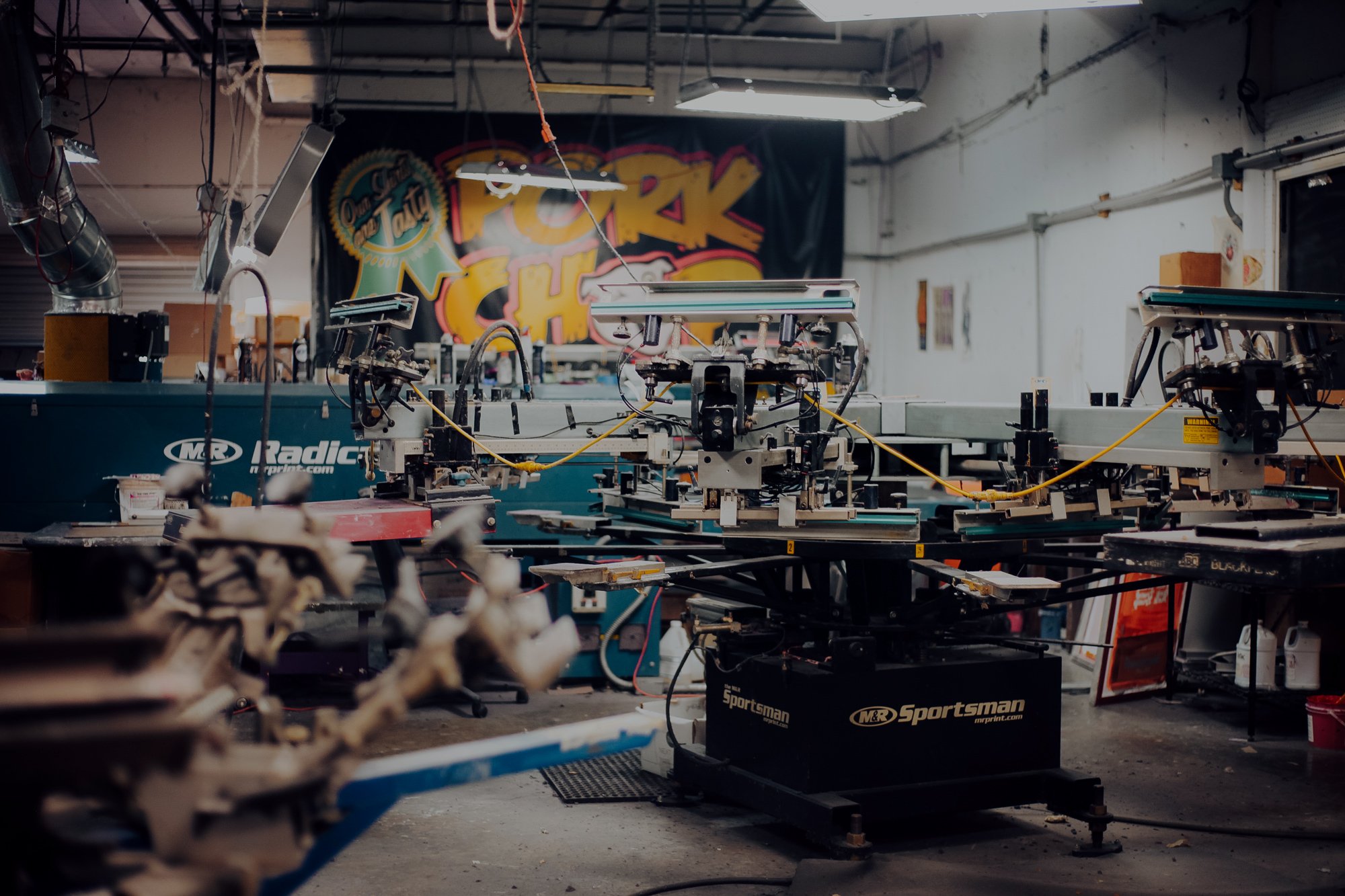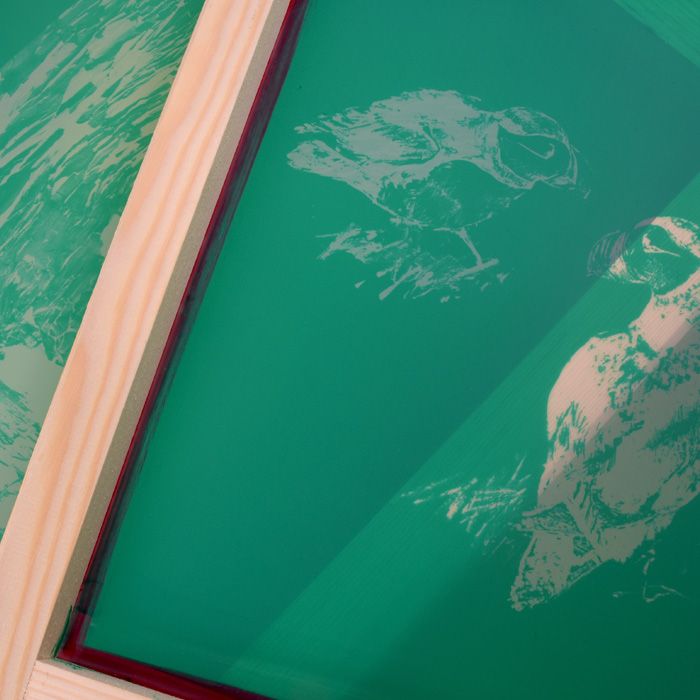High-Volume T-Shirt Printing for Schools and Organizations
Wiki Article
Display Printing Uncovered: Every Little Thing You Required to Know About T-Shirt and Garment Printing Methods
Display printing is a fascinating method that integrates art with method, using limitless opportunities for creativity. Ready to explore the vital aspects that make display publishing an art type?
The Essentials of Display Printing: How It Functions
When you dive right into display printing, you'll uncover it's both an art and a scientific research. At its core, display printing entails creating a stencil, or screen, that enables ink to pass with just in details areas (screen printing kit). You begin by choosing your layout and preparing your screen with a light-sensitive emulsion. When you subject this emulsion to light, it hardens, leaving your design as an adverse room.Position the display over the fabric, then utilize a squeegee to press ink through the display onto the garment. Each action is vital, and grasping them will boost your display printing abilities, changing easy garments right into one-of-a-kind, expressive items.
Kinds of Screen Printing Techniques
When you understand the basics of screen printing, it's time to explore the different methods that can raise your styles. One popular method is typical display printing, where ink is pushed with a stenciled display.Another alternative is plastisol printing, known for its resilience and brilliant shades, making it a preferred for many brand names. Experiment with halftone printing to produce gradient results and complex styles.
Essential Equipment for Display Printing
To achieve spectacular results in display printing, having the best devices is fundamental. First, you'll require a durable screen printing structure, which holds the mesh that transfers your layout onto the garment. Next, purchase high-quality mops; these are vital for applying ink evenly across the display. You'll likewise need an excellent exposure device to create your displays, along with a washout booth for cleansing them after use. A reputable heat resource, like a conveyor clothes dryer or heat press, is vital for treating your prints to ensure longevity. Do not neglect an appropriate work area, geared up with tables and storage space for your materials. Protective gear, such as handwear covers and masks, will maintain you risk-free from chemicals and inks. With the right tools, you'll be well on your means to creating professional-quality prints.Picking the Right Inks and Materials
When picking inks and materials for display printing, you require to consider the kind of ink that functions best for your job. Consider fabric compatibility to assure your designs look last and excellent lengthy. Likewise, explore environment-friendly ink choices to make your printing procedure much more sustainable.Sorts Of Screen Inks
Choosing the right display ink is important for accomplishing lively, durable prints that satisfy your task's demands. There are numerous kinds of display inks to examine. Specialized inks, such as metal or glow-in-the-dark, can add distinct results to your styles.
Fabric Compatibility Factors To Consider
Recognizing fabric compatibility is essential for achieving premium screen prints, specifically considering that various products respond distinctly to numerous inks. Always test your inks on sample textile to ensure they stick appropriately and maintain color honesty. Additionally, keep in mind that fabric weight and appearance can affect the final result, so picking the best ink and product combo is essential for your task's success.Eco-Friendly Ink Options
Environment-friendly inks are coming to be a popular selection for screen printers that want to minimize their environmental influence while maintaining high quality. When picking inks, consider water-based inks, which are much less hazardous and less complicated to cleanse up compared to traditional solvents.Furthermore, seek inks made from renewable sources, such as soy or vegetable-based alternatives. By choosing the right inks and products, you'll not just develop spectacular styles however additionally add to a much more sustainable printing procedure. Make the button, and your prints will show your dedication to the environment!
Preparing Your Design for Display Printing

File Style Needs
To ensure your design looks sharp and vivid on fabric, you'll require to pay close interest to submit format needs for screen printing. Make certain your layout has a clear history to avoid undesirable white edges on your prints. Keep color modes in mind; CMYK is common for screen printing, so convert your RGB develops accordingly.Color Separation Strategies
Color splitting up is a necessary action in preparing your design for display printing, and mastering it can substantially enhance your print top quality. You'll need to damage your style into individual colors, as each color calls for a separate screen during printing. This accuracy not only guarantees accurate color depiction however also simplifies the printing process.Resolution and Dimension
Achieving the finest lead to screen printing begins with ensuring your layout has the best resolution and dimension. Ideally, your artwork ought to go to the very least 300 DPI (dots per inch) for sharp, clear prints. Your final item may look amateur and pixelated. if you use lower resolution.When it involves size, consider the measurements click here to find out more of your print location. Design your art work to match the final print size, preferably developing it in the actual dimensions you'll be publishing. By doing this, you'll prevent any kind of unforeseen scaling problems.
Always examine your layout in both vector and raster layouts. Vector graphics can be scaled without shedding high quality, making them optimal for screen printing. Preparing correctly will ensure your style looks outstanding on every garment!
Step-by-Step Screen Printing Process
Screen printing is a vibrant procedure that enables you to create vivid designs on various surface areas. To get going, you'll need a display, emulsion, and your chosen ink. Prepare your display by cleaning it completely. Next off, apply the solution uniformly and let it dry in a dark area. When completely dry, reveal your display to light with your design put on it, which will set the solution where the light hits, developing a stencil - screen printing kit.Put ink onto the screen and use a squeegee to push the ink with the pattern onto the textile. Lift the display meticulously and let the print dry. You have actually effectively display published your style.
Tips for Successful Display Printing Projects
While you're diving right into your display printing jobs, keep in mind that prep work is vital to success. Start by gathering all your materials-- inks, displays, garments, and squeegees. A tidy work space aids protect against undesirable mistakes, so clean up prior to you start.Next, validate your artwork is high-resolution and appropriately sized for your garment. Test your screen for correct exposure and clean it thoroughly to avoid spots. When blending your inks, adhere to the maker's guidelines to achieve the appropriate uniformity.
Throughout printing, use even stress with your squeegee for constant outcomes. Do not rush; take your time to verify each print satisfies your requirements. After printing, allow your garments completely dry totally before taking care of or packaging them.
Lastly, always maintain a sample of your benefit future reference. This method, you can analyze your progression and enhance your methods over time. Happy printing!

Frequently Asked Questions
How much time Does It Take to Set up a Display Printing Task?
Establishing a display printing task generally takes about 30 mins to an hour. You'll prepare the screens, mix inks, and change journalism. The time varies based on complexity and experience, so stay organized!Can I Print on Various Material Enters Utilizing the Exact Same Strategy?
Yes, you can print on different material types making use of the same strategy, but you'll need to adjust your inks and setups. Some fabrics check here absorb ink differently, so trying out assurances the most effective results for each product.What Prevail Blunders to Avoid in Display Printing?
When screen printing, stay clear of usual mistakes like making use of the incorrect ink, disregarding correct exposure times, or skipping pre-press checks. Always test your configuration and maintain tidy displays to ensure quality results each time.Just How Can I Effectively Clean and Preserve My Screen Printing Equipment?
To properly clean and preserve your screen printing equipment, you should routinely clean screens with proper solvents, inspect squeegees for wear, and assure all devices are stored dry and dust-free. Uniformity stops pricey repair services and improves performance.Is Screen Printing Eco-friendly Contrasted to Various Other Techniques?
Screen printing can be extra eco-friendly than various other methods, specifically if you use water-based inks and eco-conscious products. By selecting sustainable materials and methods, you reduce waste and lessen your effect on the world.Display Printing Uncovered: Every Little Thing You Need to Know Concerning Tee and Garment Printing Strategies
At its core, screen printing includes developing a pattern, or screen, that allows ink to pass through only in specific locations. Placement the display read review over the textile, after that make use of a squeegee to press ink via the display onto the garment. One prominent method is traditional screen printing, where ink is pushed via a stenciled screen.When picking inks and materials for display printing, you need to take right into account the kind of ink that works ideal for your task.
Report this wiki page